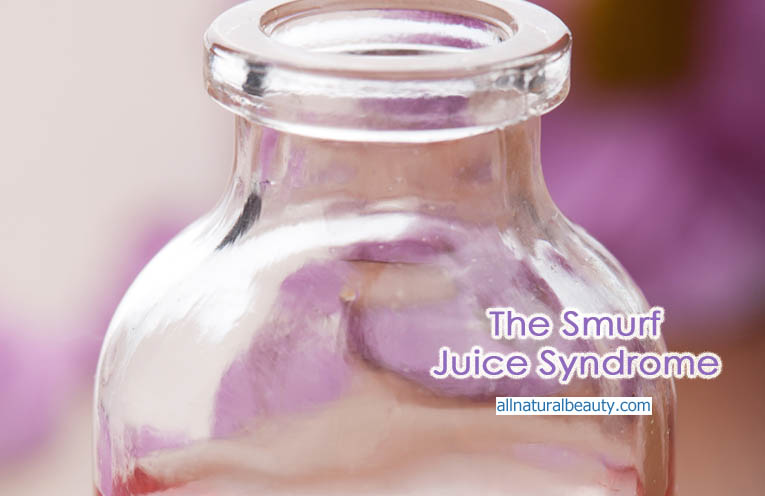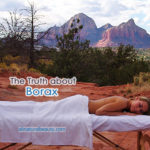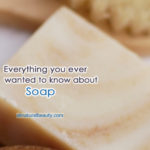
The Smurf Juice Syndrome
One day, I was visiting a new spa in the Phoenix area with another soaping friend of mine, and as we awaited our bill, we perused some of the beauty product offerings in the spa’s retail boutique. My friend picked up a small bottle filled with a conspicuously blue yet “natural” facial serum and suddenly exclaimed (not just a little loudly in the whispery quiet of the spa environment) with incredulity, “where’s the blue?!” She, a fellow formulator and artisan of her own line of handmade, natural bath and body products, was of course scrutinizing the ingredients label on the product box, because that is what we do. It is a compulsion and we can’t help ourselves, really. As far as I know, there is no 12-step program for this label-reading affliction because it doesn’t really constitute a diminishment of one’s quality of life; it’s just really annoying for anyone trying to get me to walk through any retail beauty aisle at anything resembling a brisk pace. I just can’t do it. I *have* to stop and read the ingredients.
Anyway, the problem with the ingredients listing on this particular product, however, was that it was incomplete. And anyone who formulates beauty or body care products for a living can tell this, simply by looking at it. There were actually more than a few little label lies happening in this case, but the most glaringly obvious omission was the fact that the stuff in the bottle was seriously, oceanically, azure blue. However, there was absolutely NO listing for a colorant anywhere in the ingredients. To nearly anyone else, this might simply not even matter. I mean, why NOT blue? It’s a “blueberry” serum, right? So it must be blueberries that make the serum Smurf blue, right? Even though it’s not even the color of blueberries? So what if it’s the color of Smurf juice? So what if they forgot to include blue on the label?
As creators and formulators of our own skincare and bodycare products, the ubiquitous and blatant mislabeling of products in our industry is well known to us. Yet when I tell friends, family and customers about this rampant labeling abuse, they are often shocked. Like most people (and like me, before I began making my own organic body care products over 16 years ago), they assume that there are laws and regulations and governing agencies (such as the FDA) which oversee these things to protect consumers. Right? Well, mostly. There are laws. There are rules. But you may be a bit surprised to learn there is very little, if any, actual policing or enforcement of those laws.
As indie beauty care artisans, we tend to take a great deal of care in choosing quality ingredients, painstakingly sourcing and blending and mixing and tweaking and testing (usually on friends and family) before finally releasing our creations into the world. And most of us follow the labeling laws. Many of us do so proudly, because we know how great our ingredients are and we want you to know, too. We pour our hearts and souls into our products, because we want to put something really good out into the world.
The problem with the smurf juice syndrome is that we indie brands are trying to compete on an unlevel playing field. The company that makes the smurf juice serum happens to take out two-page spreads in every spa, salon and beauty trade publication currently in circulation every month, and they claim to be offering “handmade”products using “organic” ingredients. Yet, as a literal handmaker of bodycare products using certified organic ingredients, I can assure you that this company is not. But how is the public to know the difference? How are we, as consumers, going to make informed choices if there is no transparency and truth in labeling? When the average consumer (who is not a formulator) picks up a bottle of something called “Rose Hip Toner” and the entire sum of the ingredients reads: “Rose Hip Juice” despite the fact that the product is red—very red. And despite the fact that this “rose hip juice” smells heavily of roses. And nevermind that, if I were to go out to my wild rose bushes this autumn and squeeze the juice from the ripe rose hips and put that juice in a jar and leave it on a shelf for, say, anywhere from one to two weeks at room temperature, the result would be at least fuzzy, probably covered in mold and certainly. Not. Red. And it would definitely not smell like roses. How are you, the consumer, to know that this product has to contain more than what its ingredients label suggests? I know, as a formulator, that there would have to be some type of preservative, whether natural or chemical-based, for any kind of liquid “juice” to not decompose in a bottle, unrefrigerated, unless that juice is sold in powder form. I know, too, that it is exceedingly difficult, if not impossible, to achieve or retain a natural red color in wet products. If you were to mash strawberries into a jar and leave them there, they would most certainly turn brown (and then into compost). And I can tell you that there is a fragrance in that bottle, because “rose hip juice” doesn’t smell like roses. In fact, I am not sure that there is even such a thing as “rose hip juice”. But this company, with its big advertising budget and its clever packaging will sell you its “handmade, organic rose hip juice” toner for the bargain price of $48.
There is currently new legislation being proposed to improve FDA laws for food as well as cosmetic products. And, as much as I am not looking forward to the prospect of having to pay more licensing, certifying or business fees, I think it’s long overdue. The European Union took the lead way back in 1976 with their European Cosmetics Directive, which has been improved and updated several times since, banning harmful ingredients such as known carcinogens and irritants and greatly restricting labeling nomenclature (http://ec.europa.eu/enterprise/cosmetics/html/consolidated_dir.htm). Here in the States, we’re way behind. Aside from the lack of enforcement in labeling laws, there are many substances in commercial cosmetics and beauty products today which are quite frankly, toxic. They’re toxic to humans and they’re toxic to the planet. Although the proposed FDA requirements will hopefully bring some much needed attention to the way that cosmetics are made, packaged and sold in the United States, there isn’t likely to be a substantial restriction of known harmful ingredients. There are, however, a couple of independent sites trying to bring more transparency to the formulation of beauty and skincare products, most notably the “Skin Deep” site by the Environmental Working Group, which keeps a free database of cosmetic and beauty products and their ingredients, breaking them down by safety in a rating system. Although their system is admittedly flawed and imperfect, it certainly is a step in the right direction.
But regulation and databases can’t replace good common sense. You, the consumer, already have the senses to discern labeling omissions. Next time you pick up a beauty product the color of smurf juice, even though the “FD&C Blue No. 5” isn’t listed in the ingredients, you know it’s in there.
In the meantime, I am going to endeavor to utilize this blog space to educate, inform and hopefully entertain those who would be so kind or curious as to read it. It occurred to me that there are hundreds of blogs out there from organic product reviews to nothing short of a shill for organic product sellers, but scant few from the perspective of the actual indie formulator. I make absolutely no pretenses as to my point of view: I am heck bent on purity, and so about purity I will write. I may also occasionally shill for my own products, too, but I promise to keep it to a minimum. Until next time, please remember not to believe everything you read, especially if it’s an ingredient label for a “natural” or “organic” product that is bright blue, yet doesn’t list a colorant, or preservative, among its ingredients.
–Jacquelyn Ramsey
From – Notes from a Natural Formulator, Organic Soapbox
At – WoodSprite Organic Body Website
Jacquelyn Ramsey
Contributor
Jacquelyn is the owner, founder and formulator for WoodSprite Organic Body, an online store filled with delectable all-natural soap and body care goodies. She is also a writer and has answered many questions for ANB visitors.
×
Jacquelyn Ramsey
Contributor
Jacquelyn is the owner, founder and formulator for WoodSprite Organic Body, an online store filled with delectable all-natural soap and body care goodies. She is also a writer and has answered many questions for ANB visitors.











